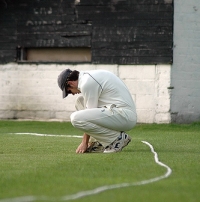|
 It was 8pm on Friday night. Ryan's phone buzzed with a new Facebook message. It was 8pm on Friday night. Ryan's phone buzzed with a new Facebook message.
"We have had a drop out, can you play in the first team tomorrow?"
The young man's heart sank. He knew what that meant: In the second team he could enjoy a jolly 40 overs at home, getting a bat and a few overs with the ball. In the firsts he is a utility: a fielder, batting at seven or eight and no chance of bowling.
Plus the game is a 40 minute drive and ten overs per innings longer. He is supposed to be going out Saturday night!
He grudgingly accepts because he is a team man. He knows his afternoon of cricket will be wasted.
A common problem
It's a problem that happens in cricket teams around the world.
The best players in club, school and Academy cricket tend to be all-rounders meaning that there is always one player who is set for an "air game" (don't bat or bowl). It might be like Ryan; a batsman at eight. It might be a bowler who doesn't get on because all the top six can also give you a dozen overs.
Whatever it is, there is an art to being the utility man when you find yourself stuck there.
The art of utility
I've seen players in this position every week. I've done it myself. I know the pain of it.
But with the right attitude, there is also an opportunity to shine and get what you want from the situation.
Here's the trick: It's not simply about "making the most of it".
The standard advice to a player in the utility role is to relax and enjoy it. The pressure is off, you are not expected to perform. If you score a cameo 25 you have exceeded expectations.
So, soak up the experience of the higher level, show you are ready for a bigger chance, field like a demon and take advantage of any moment to bat or bowl you get no matter how small.
The idea behind this is that you want to be picked in the side on batting or bowling merit and not just to make up the numbers.
This is great advice for players who want to make the step up. If you are one of those guys you probably go down to the ground early for an extra net to practice your death batting. You're excited by the chance!
Back to the small pond
What if you don't want that?
What if all you want is to play at a level you know you can do well and have a chance to play?
There are several players like this at my club. It's not my approach, but I understand it. Cricket is a long game and everyone has other pressures. You want to enjoy your weekend run out; not be pushing hard to become a first team player when you feel like you will probably never make it anyway.
You want to get back as fast as possible, but you also don't want to let down the team. It's easy to think that by doing badly and being grumpy you will not get asked again. This isn't what you do.
Here is what you do.
You do your job as well as you can: Keep a positive attitude. See it as a chance to play against better opponents that will make playing at lower levels easier.
You can also learn from players on your side; get advice, watch the captain, perhaps if you have lots of experience chip in with ideas for yourself.
Then, have a quiet word with the skipper. Tell him while you are prepared to help as much as needed, you would much rather be somewhere else and you are finding it hard to enjoy playing.
Even the most grim-faced captain will understand your plight.
Then offer to do it on a rotation system with other, similar players. This week it's you but you know you will not be asked for another month because it's someone else's turn.
It's a compromise on both sides, but at least you get your go without being selfish and at least the first team get a decent fill in player without ruining your season.
I can that a fill-in win-win.
Discuss this article with other subscribers
|

.jpg)



.jpg)

